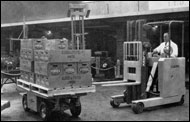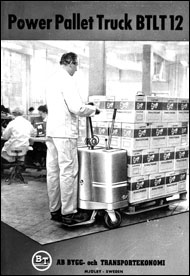 In the run up to Christmas 1960, Clark launched their first reach truck. The company used the site of what would become the new Sheffield market to exhibit the new N.R. 40. This machine had a lifting capacity of 2 tons and could operate in an aisle of 6 ft 6 in. Both rear wheels were driven, and the operator had the benefit of power-assisted steering.
In the run up to Christmas 1960, Clark launched their first reach truck. The company used the site of what would become the new Sheffield market to exhibit the new N.R. 40. This machine had a lifting capacity of 2 tons and could operate in an aisle of 6 ft 6 in. Both rear wheels were driven, and the operator had the benefit of power-assisted steering.
Conveyancer chose February 1961 to announce the details of improvements to their recently launched TC-4 and TC-5 forklift trucks. These machines were now to be offered with torque converter drive similar to the new TC-6 model. One month later the company joined Raymond of America in forming a new company in Britain. The Raymond products of battery-operated reach trucks, straddle and pallet trucks, together with their narrow aisle equipment, would be produced and marketed in Britain under the Conveyancer-Raymond banner. The Conveyancer IC machines would still be built and sold in Britain but marketed in America to supplement the Raymond product range.
Another agreement made at this time was between Lansing Bagnall Ltd and the Towmotor Company of America. It covered a complete interchange of knowledge and experience, as well as defining the marketing and manufacturing rights of their respective equipment. The parties in this reciprocal agreement complemented each other because whereas Lansing Bagnall had concentrated on battery powered trucks from 750 lbs to 7,000lbs lifting capacity, Towmotor were mainly engine powered trucks with capacities of 1,500 lbs to 60,000 lbs. Originally this figure was up to 18,000 lbs, but the purchase of the Gerlinger Carrier Company of Dallas, Oregon back in 1956 gave them the option of offering the extra capacities. The Towmotor product was made available to the Lansing Bagnall organisation in all countries outside the Americas, except Denmark, Australia and New Zealand. In return, Towmotor would market Lansing Bagnall equipment throughout North and South America.
 BT Industries in Sweden purchased Rolatruc in Britain as its first wholly owned overseas subsidiary and celebrated by launching a new battery powered, pedestrian controlled pallet truck. Known as the BTLT 12, it had a lifting capacity of 2,600 lbs, and through its hand-operated tiller arm could make 100 deg turns in either direction. An unusual feature on a truck of this type was the ‘stand on’ platform on the rear that the operator could use for travelling long runs. This platform was spring-loaded, and permanently raised when not required. The drive motor was housed inside the drive wheel and was easily removed for servicing. Lift hydraulics were supplied from a motorised pump, activated by a push-button on the top of the tiller arm; the lowering function was by a manually operated lever. If required, the truck could be supplied with all the hydraulic functions to be manually operated.
BT Industries in Sweden purchased Rolatruc in Britain as its first wholly owned overseas subsidiary and celebrated by launching a new battery powered, pedestrian controlled pallet truck. Known as the BTLT 12, it had a lifting capacity of 2,600 lbs, and through its hand-operated tiller arm could make 100 deg turns in either direction. An unusual feature on a truck of this type was the ‘stand on’ platform on the rear that the operator could use for travelling long runs. This platform was spring-loaded, and permanently raised when not required. The drive motor was housed inside the drive wheel and was easily removed for servicing. Lift hydraulics were supplied from a motorised pump, activated by a push-button on the top of the tiller arm; the lowering function was by a manually operated lever. If required, the truck could be supplied with all the hydraulic functions to be manually operated.
In the latter part of the year a new Conveyancer battery-operated counterbalance truck was released in Britain with a lifting capacity of 7,000 lbs. Replacing the model E 67-24, the model E 7-24 was distinguished from other equipment of the day by the two foot wide brake pedal. This long metal bar, as part of the pedal’s construction, was clad in wood to help prevent the operator’s feet slipping off when wet.
By James Brindley, Director, National Fork Truck Heritage Centre




1 Comment
We have a conveyencer 3 ton fork lift which has been in daily service with us for the last 18 years. We are now to retire all 5724kg of the perkins engined machine. It smokes to much for inside, other than that it still goes ok. Anyone interested in it? Frank Harris 17/01/12.